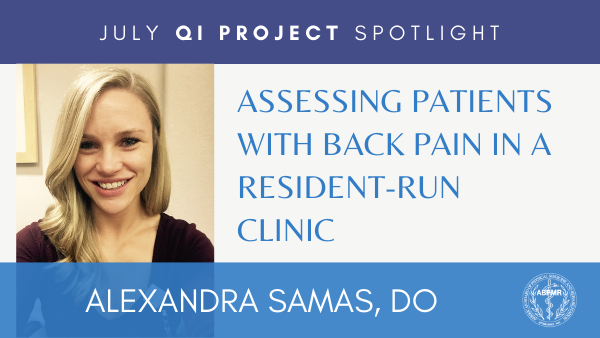CC
QI Spotlight: Assessing Patients With Back Pain in a Resident-Run Clinic

The July QI project was submitted by Alexandra Samas, DO. Dr. Samas completed this project during her residency at Stony Brook University in Long Island, NY, where she graduated in 2019. She is now consulting at Summit Medical Consultants in Denver.
Dr. Samas noticed that due to a frequent rotation of residents in her outpatient clinic, there was a lack of continuity in assessing lower back pain in patients. For her project, she provided the Oswestry Disability Index (ODI) survey for patients experiencing lower back pain to create a baseline assessment for each patient's visit.
A chart review after 5 weeks revealed that 80% of the sampled charts contained a completed ODI, which achieved Dr. Samas' initial goal of 75% completed ODIs.
Thank you for submitting your QI project, Dr. Samas!
The QI Project Spotlight (formerly the PIP Spotlight) is a periodic feature on the ABPMR News Center to highlight exemplary Quality Improvement projects submitted by your fellow diplomates (or residents) for continuing certification (CC) credit. Diplomates can use the QI Project Spotlight as a tool to plan their own QIs or as a way to connect with other diplomates doing similar work.

What is the problem you are trying to solve?
Being a resident-run clinic with rotating residents every few months, there is a lack of continuity within the clinic setting. A patient rarely sees the same resident twice. Since a large majority of our patients have complaints of lower back pain, the goal is to better assess their perception of their pain. By having patients fill out the ODI [Oswestry Disability Index], this gives us an idea of how patients feel their pain impacts their ADLs [activities of daily living] and quality of life. Doing this and documenting the score would allow for a baseline assessment to be passed from visit to visit. This would provide better continuity, despite the rotating residents.
What data (objective measurements) do you have that supports this as a problem?
With doing a full chart review, it was clear that every resident uses their own template with different physical examinations and special tests documented. Unless a patient had a follow-up within a few weeks, this discrepancy was noticed with every encounter. This was more evident in patients with complaints of back pain. It is unclear whether this is due to a larger variability in physical examination for the lumbar spine, or because of the pure volume of patients with complaints of lower back pain. Regardless of the reason, it was obvious that there was poor continuity between subsequent visits.
What is your opportunity statement? State the goal you hope to achieve.
The initial goal is to get at least 75% compliance with filling out the ODI. This will allow for better evaluation of the patients, and provide a documented score that can be placed in their chart. I wanted to have this completed within a 5-week time frame. It would give us the opportunity to eventually see if our interventions improved their perception of their symptoms/pain, as well as provide continuity between providers.
What is the underlying cause of the performance/quality problem?
With a teaching hospital, there is no true continuity of care. Residents rotate through the clinic and patients rarely see the same physician every time. It is difficult for the patient to get a regulated evaluation, as every physician has their own way of doing the H&P [history and physical]. This lack of continuity makes it difficult to assess how much is improving or worsening between visits. This was realized by speaking with the patients, who made comments such as, “You do things differently from your colleagues.” Also, there are often significant time gaps between visits, and even if the same physician saw the patient, it is difficult to fully compare each assessment.

What change(s) did you implement?
The initial change that was implemented was adding the ODI survey to each encounter when the patient had a chief complaint of back pain. What this required was a full chart review of the patients prior to the start of clinic to screen for consults pertaining to back pain, as well as asking for the survey to be completed as part of each visit. This score was then documented in the chart to provide a baseline for the patient, which will allow for better evaluation at subsequent encounters. This change is meant to standardize each patient’s pain, and use their own initial perception as a control.

Did you achieve your goal or target from your opportunity statement? What data do you have to support your conclusion?
Yes, our goal was achieved. After 5 weeks, a chart review was performed which revealed that 80% of the sampled charts contained a completed ODI. There was a total of 222 patients seen, 87 of which had a chief complaint of lower back pain. 70 patients completed the ODI and 17 did not.

Will you continue with the changes you have implemented?
Yes, the initial goal was achieved, and the plan is to continue with this assessment to provide for better patient care. We will continue to provide the ODI survey to every new patient with a chief complaint of lower back pain and document the score. The plan going forward is to use this evaluation to assess how well certain interventions worked for the patient (PT, acupuncture, chiropractor, etc), and help to guide further intervention. This clinic is mostly resident-run, which will not change in the near future. Although seeing different residents is not a bad thing, providing a baseline evaluation can help to standardize the patient’s perception of pain/disability, as well as use the patient as their own control for all future visits. Doing this will allow us to provide better care for the patient and hopefully show improvements in the ODI over time.

